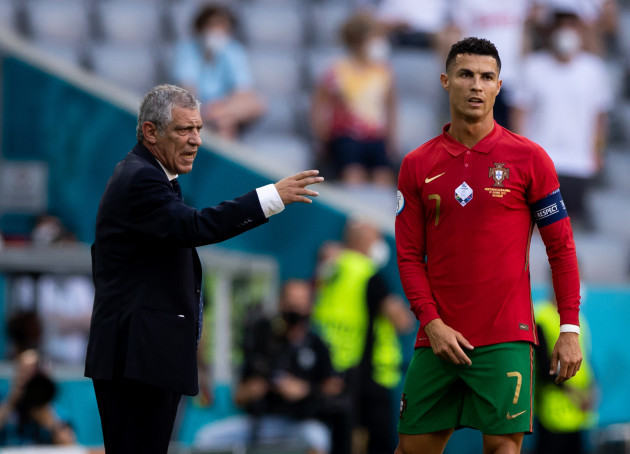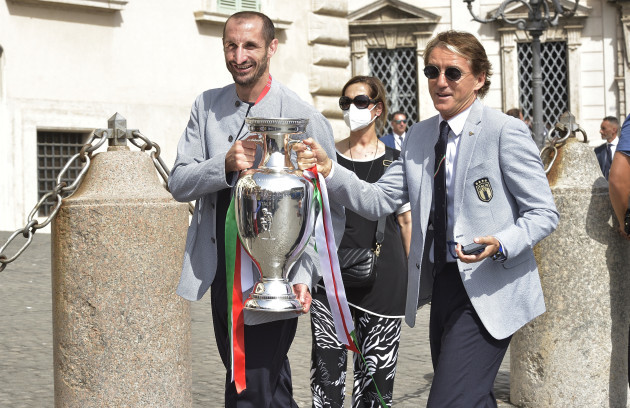“CAN BONO SAVE the world?” screamed the headline on TIME magazine back in 2002.
The jury is still out on that one, but 19 years on, he and his title song at least saved a bit of Irish representation at Euro 2020.
We might have played in these Euros and should have co-hosted them, but a coalition of three Irish managers, a feckless football association and Nphet public health advice put paid to those ambitions.
Still, every failure is an opportunity for growth, and here are a few things Stephen Kenny and his team can take from the Euros into World Cup qualifying…
Portugal’s vulnerabilities
Ireland’s next World Cup qualifier is away to Portugal in September, and it wears a daunting hue. Portugal have home advantage and one of their galaxy of attacking stars, Cristiano Ronaldo, can become the all-time record goalscorer in men’s international football with a single goal against Ireland.
Portugal lost their title but hardly disgraced themselves at the Euros: they squeezed out of the Group of Death by beating Hungary and drawing with France before a fraught and bitty last-16 exit to Belgium.
Stephen Kenny attended Portugal’s games with Germany and France, and the good news is they were games in which they did show vulnerabilities. Manager Fernando Santos struggled to integrate all his attacking stars from the start of the competition, and there was a yawning chasm between the front four and defensive six when Renato Sanches wasn’t on the pitch to link play.
They looked better, ironically, when they dropped Bruno Fernandes against Hungary and played a more coherent 4-1-4-1 system featuring Sanches and Joao Moutinho.
Their most obvious problems, though, were laid bare in the 4-2 battering they took at the hands of a Germany team later exposed as deeply, deeply mediocre. Portugal simply could not live with German wing backs in Munich, with all four goals either scored or created by one of Robin Gosens and Joshua Kimmich.
Gosens in particular wreaked havoc down Portugal’s right flank: with full-back Nelson Semedo dragged in field to mark Serge Gnabry, Bernardo Silva offered little to no protection. It was an obvious problem, yet Santos couldn’t fix it. He tried Sanches in Silva’s position for the second half for a little while – Germany scored twice more – and the only relief came when Jogi Low substituted Gosens.
Ireland have played with wing backs pretty regularly under Kenny, so Germany have offered Ireland somewhat of a template on how Portugal can be attacked. That said, it carries a few health warnings. Firstly, Joao Cancelo will likely be at right-back in September rather than the hapless Semedo.
And secondly, to pull it off, Germany had to push very high up the pitch, which is somewhat easier when you have Toni Kroos to dictate play in midfield. Ireland don’t exactly have that level of quality.
Three at the back
What a tournament it proved to be for the humble back three.
At Euro 2016, only six of the last-16 at Euro 2016 played with a back three at some stage or another, and one of them, Slovakia, did so for all of eight minutes to close out a group game.
This time around, only four of the sides in the last-16 did not play a back three at some point across the tournament: Spain, Czech Republic, and Portugal all stuck with a back four, while Sweden played a…flat-pack four.
(Granted, of the 12 sides who did play it, France did so to disastrous effect against Switzerland and Italy played it for just 20 minutes to close out a win against the same side.)
Sides who could adapt from a back four to a back three and vice versa did particularly well at this tournament: England, most obviously, but also Denmark, who switched very effectively to that system in Christian Eriksen’s absence.
Juggling the two systems should be something Ireland will be able to do, given they started playing with a back four under Kenny before switching to a back three against Serbia, Luxembourg, Qatar and Hungary this year.
Ireland’s swapping to a back three has been often done out of injury-enforced necessity, but unfortunate circumstance has forced Ireland to hit upon a prevailing tactical trend across international football in Europe.
There is time to work on things…
One of the nagging doubts of Kenny’s reign thus far has been whether it is feasible in international football to affect the kind of change the manager has spoken of; whether there is simply not enough time on the training pitch to transmit ideas.
Roberto Mancini and Italy showed that it very much is possible: they pressed and attacked with the cohesion of a club side and their attacking game was quite sophisticated.
Each player was clear roles based on their position: the left-back (Spinazzola and then Emerson) pushed high up the field in possession to link up with the left-sided attacker (Insigne), meaning the right-back (Di Lorenzo) shuffled across to create a back three.
The right-sided attacker (either Berardi or Chiesa, usually) kept wide to that touchline, to give space to the right-sided central midfielder (Barella) run forward from deep. Italy were an example of what is possible when a good coach has a very clear vision of how he wants his side to play.
We are yet to see that kind of clarity of intent from Ireland, but the recent friendly games against Andorra and Hungary showed mildly encouraging signs of attacking patterns from the training ground coming to fruition, most notably with effective crosses coming from what Kenny has called the ‘De Bruyne position.‘
…and that change is more necessary than ever
The consensus before the European Championships was that international football lagged behind club football, whose embrace of high performance, high pressing and high-wire defensive acts turned it into a much higher-scoring affair than its counterpart.
In contrast, the teams who had been successful in international football were doughty, deep-lying sides like Portugal and France, who rarely allowed their full-backs cross the halfway line.
And then along came Euro 2020 to rebalance things and remind us that the attacking sides are generally the best-rewarded.
These Championships had the highest rate of goals-per-game of any Euros since it expanded to more than four teams, while Italy won as the most attacking side in the competition: they had the highest number of goals, shots, expected goals, successful dribbles, and offsides.
England, meanwhile, came agonisingly close to winning the tournament, but were left to rue their conservatism, particularly in settling so soon in Sunday’s final with only one goal.
With more goals being scored than ever, it adds further urgency to Stephen Kenny’s task: to make Ireland more effective going forward. There was nothing wrong with the defensive record under Mick McCarthy – five conceded in qualifying was one fewer than both Switzerland and Denmark let in – but the total seven goals scored was pitiful.
That wasn’t enough to qualify for Euro 2020, and it won’t be enough from here on, either.




